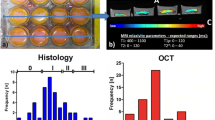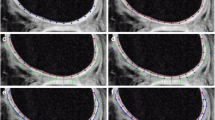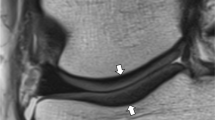Abstract
Purpose
To investigate the association of quantitative magnetic resonance imaging (qMRI) parameters with arthroscopic grading of cartilage degeneration. Arthroscopy of the knee is considered to be the gold standard of osteoarthritis diagnostics; however, it is operator-dependent and limited to the evaluation of the articular surface. qMRI provides information on the quality of articular cartilage and its changes even at early stages of a disease.
Methods
qMRI techniques included T 1 relaxation time, T 2 relaxation time, and delayed gadolinium-enhanced MRI of cartilage mapping at 3 T in ten patients. Due to a lack of generally accepted semiquantitative scoring systems for evaluating severity of cartilage degeneration during arthroscopy, the International Cartilage Repair Society (ICRS) classification system was used to grade the severity of cartilage lesions. qMRI parameters were statistically compared to arthroscopic grading conducted with the ICRS classification system.
Results
qMRI parameters were not linearly related to arthroscopic grading. Spearman’s correlation coefficients between qMRI and arthroscopic grading were not significant. The relative differences in qMRI parameters of superficial and deep cartilage varied with degeneration, suggesting different macromolecular alterations in different cartilage zones.
Conclusions
Results suggest that loss of cartilage and the quality of remaining tissue in the lesion site may not be directly associated with each other. The severity of cartilage degeneration may not be revealed solely by diagnostic arthroscopy, and thus, qMRI can have a role in the investigation of cartilage degeneration.


Similar content being viewed by others
References
Aigner T, Gluckert K, von der Mark K (1997) Activation of fibrillar collagen synthesis and phenotypic modulation of chondrocytes in early human osteoarthritic cartilage lesions. Osteoarthritis Cartilage 5:183–189
Atkinson G, Nevill AM (1998) Statistical methods for assessing measurement error (reliability) in variables relevant to sports medicine. Sports Med 26:217–238
Ayral X, Dougados M, Listrat V, Bonvarlet J, Simonnet J, Poiraudeau S, Amor B (1993) Chondroscopy: a new method for scoring chondropathy. Semin Arthritis Rheum 22:289–297
Bank RA, Soudry M, Maroudas A, Mizrahi J, TeKoppele JM (2000) The increased swelling and instantaneous deformation of osteoarthritic cartilage is highly correlated with collagen degradation. Arthritis Rheum 43:2202–2210
Berberat JE, Nissi MJ, Jurvelin JS, Nieminen MT (2009) Assessment of interstitial water content of articular cartilage with T1 relaxation. Magn Reson Imaging 27:727–732
Binks DA, Hodgson RJ, Ries ME, Foster RJ, Smye SW, McGonagle D, Radjenovic A (2013) Quantitative parametric MRI of articular cartilage: a review of progress and open challenges. Br J Radiol 86:20120163
Brismar BH, Wredmark T, Movin T, Leandersson J, Svensson O (2002) Observer reliability in the arthroscopic classification of osteoarthritis of the knee. J Bone Joint Surg Br 84:42–47
Brittberg M, Winalski CS (2003) Evaluation of cartilage injuries and repair. J Bone Joint Surg Am 85-A(Suppl 2):58–69
Broderick LS, Turner DA, Renfrew DL, Schnitzer TJ, Huff JP, Harris C (1994) Severity of articular cartilage abnormality in patients with osteoarthritis: evaluation with fast spin-echo MR vs arthroscopy. Am J Roentgenol (AJR) 162:99–103
Buckwalter JA, Mankin HJ (1998) Articular cartilage: degeneration and osteoarthritis, repair, regeneration, and transplantation. Instr Course Lect 47:487–504
Chu CR, Williams A, Tolliver D, Kwoh CK, Bruno S III, Irrgang JJ (2010) Clinical optical coherence tomography of early articular cartilage degeneration in patients with degenerative meniscal tears. Arthritis Rheum 62:1412–1420
Dahlberg L, Lammentausta E, Tiderius CJ, Nieminen MT (2012) In vivo monitoring of joint cartilage. Lessons to be learned by contrast-enhanced MRI of cartilage (dGEMRIC). Eur Musculoskelet Rev 7:58–62
David-Vaudey E, Ghosh S, Ries M, Majumdar S (2004) T2 relaxation time measurements in osteoarthritis. Magn Reson Imaging 22:673–682
Dunn TC, Lu Y, Jin H, Ries MD, Majumdar S (2004) T2 relaxation time of cartilage at MR imaging: comparison with severity of knee osteoarthritis. Radiology 232:592–598
Eckstein F, Cicuttini F, Raynauld JP, Waterton JC, Peterfy C (2006) Magnetic resonance imaging (MRI) of articular cartilage in knee osteoarthritis (OA): morphological assessment. Osteoarthritis Cartilage 14(Suppl A):A46–A75
Fife RS, Brandt KD, Braunstein EM, Katz BP, Shelbourne KD, Kalasinski LA, Ryan S (1991) Relationship between arthroscopic evidence of cartilage damage and radiographic evidence of joint space narrowing in early osteoarthritis of the knee. Arthritis Rheum 34:377–382
Gillis A, Bashir A, McKeon B, Scheller A, Gray ML, Burstein D (2001) Magnetic resonance imaging of relative glycosaminoglycan distribution in patients with autologous chondrocyte transplants. Invest Radiol 36:743–748
Glaser C, Mendlik T, Dinges J, Weber J, Stahl R, Trumm C, Reiser M (2006) Global and regional reproducibility of T2 relaxation time measurements in human patellar cartilage. Magn Reson Med 56:527–534
Guermazi A, Roemer FW, Haugen IK, Crema MD, Hayashi D (2013) MRI-based semiquantitative scoring of joint pathology in osteoarthritis. Nat Rev Rheumatol 9:236–251
Hannila I, Raina SS, Tervonen O, Ojala R, Nieminen MT (2009) Topographical variation of T2 relaxation time in the young adult knee cartilage at 1.5 T. Osteoarthritis Cartilage 17:1570–1575
Hirvasniemi J, Kulmala KA, Lammentausta E, Ojala R, Lehenkari P, Kamel A, Jurvelin JS, Toyras J, Nieminen MT, Saarakkala S (2013) In vivo comparison of delayed gadolinium-enhanced MRI of cartilage and delayed quantitative CT arthrography in imaging of articular cartilage. Osteoarthritis Cartilage 21:434–442
Hunter DJ, Guermazi A, Lo GH, Grainger AJ, Conaghan PG, Boudreau RM, Roemer FW (2011) Evolution of semi-quantitative whole joint assessment of knee OA: MOAKS (MRI Osteoarthritis Knee Score). Osteoarthritis Cartilage 19:990–1002
Hunter DJ, Lo GH, Gale D, Grainger AJ, Guermazi A, Conaghan PG (2008) The reliability of a new scoring system for knee osteoarthritis MRI and the validity of bone marrow lesion assessment: BLOKS (Boston Leeds Osteoarthritis Knee Score). Ann Rheum Dis 67:206–211
Joseph GB, Baum T, Alizai H, Carballido-Gamio J, Nardo L, Virayavanich W, Lynch JA, Nevitt MC, McCulloch CE, Majumdar S, Link TM (2012) Baseline mean and heterogeneity of MR cartilage T2 are associated with morphologic degeneration of cartilage, meniscus, and bone marrow over 3 years–data from the Osteoarthritis Initiative. Osteoarthritis Cartilage 20:727–735
Kimelman T, Vu A, Storey P, McKenzie C, Burstein D, Prasad P (2006) Three-dimensional T1 mapping for dGEMRIC at 3.0 T using the Look Locker method. Invest Radiol 41:198–203
Koff MF, Parratte S, Amrami KK, Kaufman KR (2009) Examiner repeatability of patellar cartilage T2 values. Magn Reson Imaging 27:131–136
Kornaat PR, Ceulemans RY, Kroon HM, Riyazi N, Kloppenburg M, Carter WO, Woodworth TG, Bloem JL (2005) MRI assessment of knee osteoarthritis: Knee Osteoarthritis Scoring System (KOSS)—inter-observer and intra-observer reproducibility of a compartment-based scoring system. Skelet Radiol 34:95–102
Lammentausta E, Kiviranta P, Toyras J, Hyttinen MM, Kiviranta I, Nieminen MT, Jurvelin JS (2007) Quantitative MRI of parallel changes of articular cartilage and underlying trabecular bone in degeneration. Osteoarthritis Cartilage 15:1149–1157
Lammentausta E, Kiviranta P, Nissi MJ, Laasanen MS, Kiviranta I, Nieminen MT, Jurvelin JS (2006) T2 relaxation time and delayed gadolinium-enhanced MRI of cartilage (dGEMRIC) of human patellar cartilage at 1.5 T and 9.4 T: relationships with tissue mechanical properties. J Orthop Res 24:366–374
Madry H, Luyten FP, Facchini A (2012) Biological aspects of early osteoarthritis. Knee Surg Sports Traumatol Arthrosc 20:407–422
Mankin HJ, Thrasher AZ (1975) Water content and binding in normal and osteoarthritic human cartilage. J Bone Joint Surg Am 57:76–80
McKeag D, Smith BW, Edminster R, Laird T, Clark J, Herron S (1992) Estimating the severity of osteoarthritis with magnetic resonance spectroscopy. Semin Arthritis Rheum 21:227–238
Menezes NM, Gray ML, Hartke JR, Burstein D (2004) T2 and T1rho MRI in articular cartilage systems. Magn Reson Med 51:503–509
Mosher TJ, Dardzinski BJ (2004) Cartilage MRI T2 relaxation time mapping: overview and applications. Semin Musculoskelet Radiol 8:355–368
Mosher TJ, Smith H, Dardzinski BJ, Schmithorst VJ, Smith MB (2001) MR imaging and T2 mapping of femoral cartilage: in vivo determination of the magic angle effect. Am J Roentgenol (AJR) 177:665–669
Nieminen MT, Rieppo J, Toyras J, Hakumaki JM, Silvennoinen J, Hyttinen MM, Helminen HJ, Jurvelin JS (2001) T2 relaxation reveals spatial collagen architecture in articular cartilage: a comparative quantitative MRI and polarized light microscopic study. Magn Reson Med 46:487–493
Nissi MJ, Toyras J, Laasanen MS, Rieppo J, Saarakkala S, Lappalainen R, Jurvelin JS, Nieminen MT (2004) Proteoglycan and collagen sensitive MRI evaluation of normal and degenerated articular cartilage. J Orthop Res 22:557–564
Peterfy CG, Guermazi A, Zaim S, Tirman PF, Miaux Y, White D, Kothari M, Lu Y, Fye K, Zhao S, Genant HK (2004) Whole-Organ Magnetic Resonance Imaging Score (WORMS) of the knee in osteoarthritis. Osteoarthritis Cartilage 12:177–190
Prasad AP, Nardo L, Schooler J, Joseph GB, Link TM (2013) T1ρ and T2 relaxation times predict progression of knee osteoarthritis. Osteoarthritis Cartilage 21:69–76
Ratcliffe A, Billingham ME, Saed-Nejad F, Muir H, Hardingham TE (1992) Increased release of matrix components from articular cartilage in experimental canine osteoarthritis. J Orthop Res 10:350–358
Rubenstein JD, Kim JK, Morova-Protzner I, Stanchev PL, Henkelman RM (1993) Effects of collagen orientation on MR imaging characteristics of bovine articular cartilage. Radiology 188:219–226
Spahn G, Klinger HM, Baums M, Pinkepank U, Hofmann GO (2011) Reliability in arthroscopic grading of cartilage lesions: results of a prospective blinded study for evaluation of inter-observer reliability. Arch Orthop Trauma Surg 131:377–381
Spahn G, Muckley T, Klinger HM, Hofmann GO (2008) Whole-Organ Arthroscopic Knee Score (WOAKS). BMC Musculoskelet Disord 9:155-2474-9-155
Stubendorff JJ, Lammentausta E, Struglics A, Lindberg L, Heinegard D, Dahlberg LE (2012) Is cartilage sGAG content related to early changes in cartilage disease? Implications for interpretation of dGEMRIC. Osteoarthritis Cartilage 20:396–404
Tiderius CJ, Jessel R, Kim YJ, Burstein D (2007) Hip dGEMRIC in asymptomatic volunteers and patients with early osteoarthritis: the influence of timing after contrast injection. Magn Reson Med 57:803–805
Tiderius CJ, Olsson LE, de Verdier H, Leander P, Ekberg O, Dahlberg L (2001) (Gd-DTPA2)-enhanced MRI of femoral knee cartilage: a dose-response study in healthy volunteers. Magn Reson Med 46:1067–1071
Wang L, Regatte RR (2014) Quantitative mapping of human cartilage at 3.0T: parallel changes in T(2), T(1)rho, and dGEMRIC. Acad Radiol 21:463–471
Wiener E, Pfirrmann CW, Hodler J (2010) Spatial variation in T1 of healthy human articular cartilage of the knee joint. Br J Radiol 83:476–485
Acknowledgments
This study was supported by the grant from the Academy of Finland (Grant 260321) and the strategic funding from the University of Oulu.
Conflict of interest
The authors declare that they have no conflict of interest.
Author information
Authors and Affiliations
Corresponding author
Rights and permissions
About this article
Cite this article
Casula, V., Hirvasniemi, J., Lehenkari, P. et al. Association between quantitative MRI and ICRS arthroscopic grading of articular cartilage. Knee Surg Sports Traumatol Arthrosc 24, 2046–2054 (2016). https://doi.org/10.1007/s00167-014-3286-9
Received:
Accepted:
Published:
Issue Date:
DOI: https://doi.org/10.1007/s00167-014-3286-9




